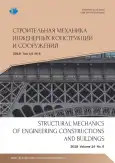Complicated features and their solution in analysis of thin shell and plate structures
- Authors: Govind P.L.1
-
Affiliations:
- Mid-Western University
- Issue: Vol 14, No 6 (2018)
- Pages: 509-515
- Section: Thin Elastic Shells Theory
- URL: https://journal-vniispk.ru/1815-5235/article/view/346350
- DOI: https://doi.org/10.22363/1815-5235-2018-14-6-509-515
- ID: 346350
Cite item
Full Text
Abstract
Introduction. It is instructive to assemble a list of applications from a historical point of view, and to take as a connecting theme the way in which the introduction of the thin shell as a structural form made an important contribution to the development of several branches of engineering. The following is a brief list, which is by no means complete and complicated features and their solutions for analysis of such structures. Solution technique, methods. The linear theory of thin elastic shells with arbitrary shape of the middle surface is derived on the basis of Kirchhoff’s assumptions that were used in the development of the plate bending theory introduced in Part I. These assumptions are formulated for the linear theory of thin shells of an arbitrary shape. The problem of the study of this article is to identify simple way of solution to analyze complicated features of thin shell structure by introducing modern and new programmable theories and aspects. Especially the intersecting line of connecting thin shell structures. Results. It is possible to successfully model explicitly a panel profile that can be used for optimization studies for use as possible future test studies. It has also been shown, that if test data exists, a numerical solution can be very accurately modeled to match the test data by modifying the material properties of the model. Discussion. The article should encourage structural engineers to solve complicated features in thin shell structures and design for construction of such structure which are rarely constructing in country like Nepal due to lack of skilled manpower.
About the authors
Prasad Lamichhane Govind
Mid-Western University
Author for correspondence.
Email: govindkhec@gmail.com
PhD in Technical Sciences, Associate Professor
Post Box 21700, Kuhine Pani, Birendranagar, Surkhet, NepalReferences
- Chernykh K.F. (1964). Linear Theory of Shells. Part 2. Leningrad State University Press. (In Russ.)
- Krivoshapko S.N., Ivanov V.N. (2015). Encyclopedia of Analytical Surfaces. Switzerland, Springer International Publishing, 752.
- Ivanov V.N., Romanova V.A. (2016). Constructional forms of the space constructions. Visualization of the surfaces at the systems MathCad, and AUTOCad. Moscow, ASV Publ., 412.
- Ivanov V.N., Krivoshapko S.N. (2010). Analytical methods of analyses of the shells of noncanonic forms. Moscow, RUDN Publ., 542.
- Graves Smith T.R., Gierlinski I.T., Walker B. (1995). A combined finite strip. Finite element method for analyzing thin walled structures. Thin Walled Struct., (3), 163-180.
- Cowper G.R., Lindberg G.M., Olson M.D. (1970). A shallow shell finite element of triangular shape. Int. J. Solids Struct., (6), 1133-1156.
- Clough R.W., Johnson R.L. (1968). A finite element approximation for the analyses of thin shells. Int. J. Solids Struct., (4), 43-60.
- Strickland G.E., Loden W.A. (1968). A doublycurved triangular shell element. Proceedings of the 2nd Conference on Matrix Methods in Structural Mechanics. Ohio, Wright-Patterson AFB.
- Ivanov V.N. (2008). The base of the finite element method and the variation-difference method. Moscow: RUDN Publ., 168.
- Furnike T. (1972). Computerized multiple level substructuring analysis. J. Comput. Struct., (2), 1063-1073.
- Noor A.K., Kamel H.A., Fulton R.E. (1978). Substructuring techniques status and projections. J. Comput. Struct., 8(5), 621-632.
- Totoev Y.Z. (1988). Stress-strain state of the combined plate & shell type structures. Ph.D. Thesis. Kiev State Technical University of Construction and Architecture. (In Russ.)
- Totoev Y.Z., Gotsulyak E.A. (1995). The use of the curvilinear mesh method in a super-element procedure for analysis of complex thin-walled structures. Proceedings of the 14 Australian Conference on the Mechanics of Structures and Materials, Hobart, Tasmania, (1), 124-129.
- Govind L. (2004). At analyses of the section of the shell of complex geometry. Materials of the All-Russian exhibition of the technical-science creation of the youth (NTTM-2004), Moscow, VVC, 7-10 April 2004, 14-15.
- Ivanov V.N., Govind L. (2005). Connection of coordinates on surfaces and global coordinates system for Monge’s surfaces. Structural Mechanics of Engineering Constructions and Buildings, (1), 43-48. (In Russ.)
- Govind L. (2007). Analyses of intense-deformed condition of crossing sections of shells by methods of global elements. Diss. of Ph. Doc. of Technical Sciences. Moscow, RUDN Publ., 143.
- Ivanov V.N. (2008). The problems of analyses of combined thin space constructions. Engineering Systems - 2008, Russian Science-Practical Conference. Moscow, 7-8 April. Moscow, RUDN Publ., 195-201.
- Ivanov V.N., Rizvan Muhammad. (2002). Geometry of Monge surfaces and construction of the shells. Structural Mechanics of Engineering Constructions and Buildings. Interuniversity Collection of Science Works, (11), 27-36. Moscow, ASV Publ.
- Ivanov V.N. (1982). Variation-difference method of analyses of plates and shells. Analyses and design of building constructions. Moscow, UDN Publ., 131-141.
- Ivanov V.N., Nasr Yunes Abbushy. (2000). Analyses of the shells of complex geometry by variationdifference method. Structural Mechanics of Engineering Constructions and Buildings. Interuniversity Collection of Science Works, (9), 25-34. Moscow, ASV Publ.
- Ivanov V.N., Kushnarenko I.V. (2013). The Variational-Difference Method for the Analysis of the Shells with Complex Geometry. International Association for Shell and Spatial Structures. Proceedings of the IASS 2013 Symposium “Beyond the Limits of Man”, Wraclaw, Poland, 23-27 September 2013. Full Papers. Paper ID 1410. Wroclaw, Oficyna Wydawnica Politechniki Wroclawskiej, 6
Supplementary files









